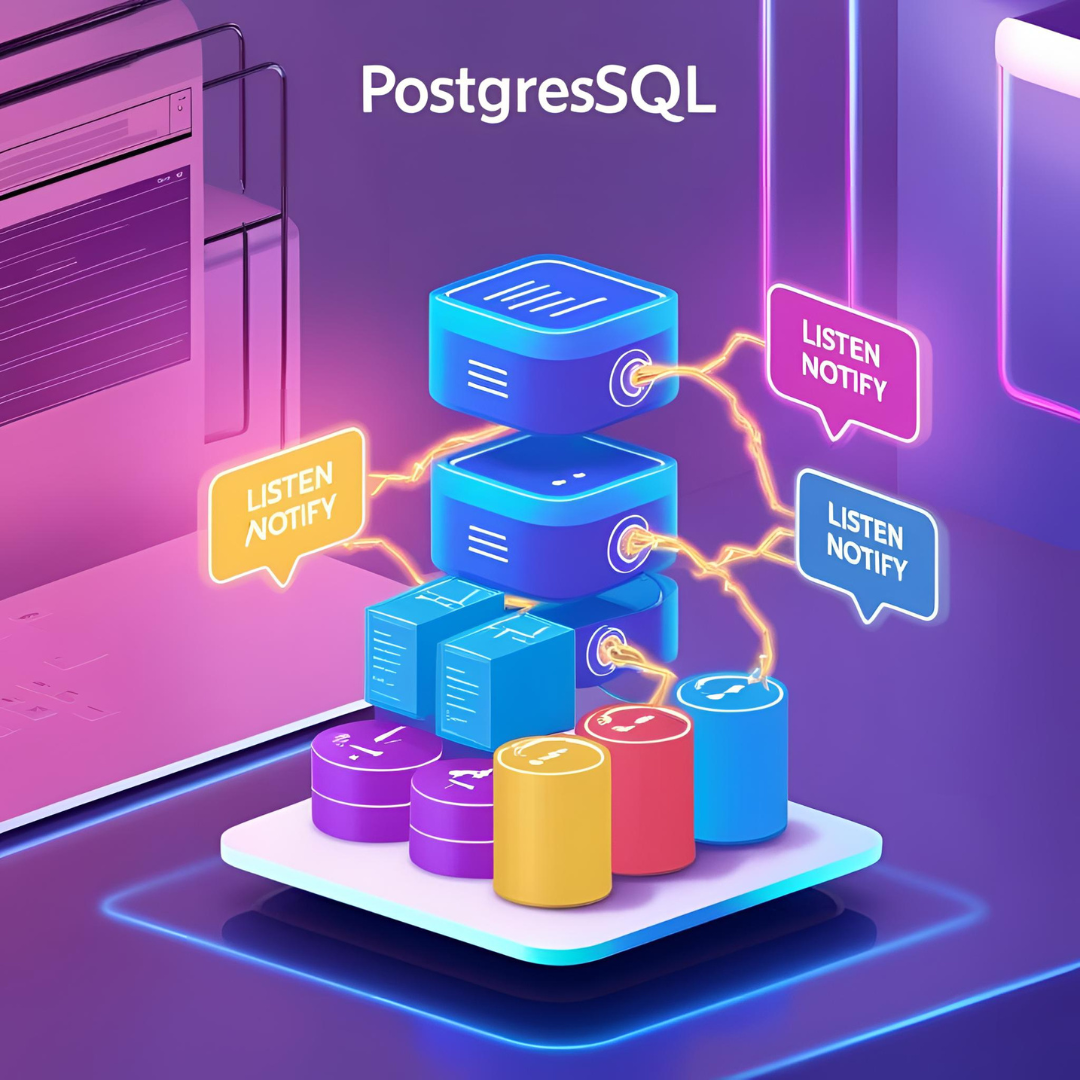Modern web applications increasingly demand real-time data updates to provide responsive and dynamic user experiences. While traditional polling mechanisms have been the go-to solution for years, they’re inefficient and resource-intensive. PostgreSQL offers a powerful alternative through its native pub/sub capabilities with the LISTEN/NOTIFY mechanism, which pairs elegantly with WebSockets to deliver true real-time data flow.
Understanding PostgreSQL’s LISTEN/NOTIFY System
At its core, PostgreSQL’s LISTEN/NOTIFY is an asynchronous communication mechanism that enables database-driven events. This built-in feature allows applications to:
- Subscribe to notifications through database connections
- Broadcast events when data changes occur
- Deliver payloads with relevant information about the changes
This system operates on three key commands:
LISTEN: Registers a connection as a listener for a specific channelNOTIFY: Sends a notification to all listeners on a specified channelUNLISTEN: Removes a listener from a channel
The WebSocket Connection
WebSockets provide persistent connections between clients and servers, allowing bidirectional data flow without the overhead of repeated HTTP requests. When combined with PostgreSQL’s LISTEN/NOTIFY mechanism, you create a powerful pipeline:
- Database changes trigger notifications through PostgreSQL
- Server application receives these notifications and processes them
- WebSockets transmit the relevant updates to connected clients
- Client applications update their UI without page refreshes
Implementation Architecture
1. Database Setup
First, we need to create triggers that will notify about relevant data changes:
sql-- Create a function to notify about changes
CREATE OR REPLACE FUNCTION notify_data_change() RETURNS TRIGGER AS $$
BEGIN
-- Convert the new row to JSON and send as payload
PERFORM pg_notify(
'data_changes',
json_build_object(
'table', TG_TABLE_NAME,
'action', TG_OP,
'data', row_to_json(NEW)
)::text
);
RETURN NEW;
END;
$$ LANGUAGE plpgsql;
-- Apply the trigger to tables you want to monitor
CREATE TRIGGER products_notify_trigger
AFTER INSERT OR UPDATE OR DELETE ON products
FOR EACH ROW EXECUTE PROCEDURE notify_data_change();
2. Server-Side Implementation (Node.js with pg and ws)
Next, we’ll set up a Node.js server that listens for PostgreSQL notifications and forwards them to connected WebSocket clients:
javascriptconst { Pool } = require('pg');
const WebSocket = require('ws');
// Create PostgreSQL connection pool
const pool = new Pool({
connectionString: 'postgresql://user:password@localhost:5432/database'
});
// Set up WebSocket server
const wss = new WebSocket.Server({ port: 8080 });
// Store connected clients
const clients = new Set();
// WebSocket connection handler
wss.on('connection', (ws) => {
// Add new client to the set
clients.add(ws);
ws.on('close', () => {
// Remove client when connection closes
clients.delete(ws);
});
});
// Set up database listener connection
(async () => {
// Dedicated connection for listening
const client = await pool.connect();
try {
// Listen for notifications on the data_changes channel
await client.query('LISTEN data_changes');
// Event handler for notifications
client.on('notification', (msg) => {
const payload = JSON.parse(msg.payload);
// Broadcast to all connected WebSocket clients
clients.forEach(client => {
if (client.readyState === WebSocket.OPEN) {
client.send(JSON.stringify(payload));
}
});
});
console.log('Listening for PostgreSQL notifications...');
} catch (error) {
console.error('Error setting up notification listener:', error);
client.release();
}
})();
3. Client-Side Implementation
Finally, implement WebSocket handling in your frontend application:
javascript// Establish WebSocket connection
const socket = new WebSocket('ws://localhost:8080');
// Handle incoming messages
socket.addEventListener('message', (event) => {
const data = JSON.parse(event.data);
// Handle different types of updates
switch (data.table) {
case 'products':
updateProductsUI(data);
break;
case 'orders':
updateOrdersUI(data);
break;
// Handle other tables as needed
}
});
// UI update function example
function updateProductsUI(data) {
if (data.action === 'INSERT') {
addProductToUI(data.data);
} else if (data.action === 'UPDATE') {
updateProductInUI(data.data);
} else if (data.action === 'DELETE') {
removeProductFromUI(data.data.id);
}
}
Performance Considerations
When implementing LISTEN/NOTIFY for real-time applications, consider these performance aspects:
- Connection management: Maintain dedicated connections for notifications to prevent blocking regular queries
- Payload size: Keep notification payloads small, containing only essential information
- Channel specificity: Use multiple channels for different types of updates to reduce processing overhead
- Client filtering: Consider sending all updates and letting clients filter what’s relevant rather than managing subscriptions server-side
Scaling the Architecture
As your application grows, you might face scaling challenges:
Connection Pooling
Each PostgreSQL connection listening for notifications takes resources. To handle many WebSocket clients:
javascript// Group notifications by type and broadcast only once per event
const uniqueNotifications = new Map();
// Process notifications in batches
setInterval(() => {
if (uniqueNotifications.size > 0) {
clients.forEach(client => {
// Send relevant notifications to each client
// ...
});
uniqueNotifications.clear();
}
}, 50); // 50ms batching interval
Multi-Server Setup
For distributed systems:
- Use Redis or other pub/sub systems as an intermediate layer
- Have PostgreSQL notify a single listener that forwards to Redis
- Allow multiple WebSocket servers to subscribe to Redis channels
Advanced Patterns
Selective Data Access
Control what data each client receives based on permissions:
javascript// When a client connects, store their access permissions
ws.on('connection', (ws, req) => {
// Authenticate and determine user permissions
const userPermissions = authenticateUser(req);
// Store permissions with the WebSocket connection
ws.userPermissions = userPermissions;
clients.add(ws);
});
// Filter notifications based on permissions
client.on('notification', (msg) => {
const payload = JSON.parse(msg.payload);
clients.forEach(client => {
if (client.readyState === WebSocket.OPEN) {
// Check if client has access to this data
if (hasAccess(client.userPermissions, payload)) {
client.send(JSON.stringify(payload));
}
}
});
});
Reliable Delivery
Ensure clients don’t miss updates during disconnections:
- Assign version numbers or timestamps to updates
- When clients reconnect, they provide their last received version
- Send any missed updates before resuming real-time notifications
Conclusion
PostgreSQL’s LISTEN/NOTIFY mechanism, when combined with WebSockets, creates a powerful foundation for real-time web applications. This approach offers several advantages over traditional methods:
- Efficiency: No polling overhead, updates only when data changes
- Simplicity: Leverages built-in database capabilities without complex middleware
- Robustness: PostgreSQL’s reliability underpins your real-time communication
- Scalability: Can be adapted for increasingly complex applications
By implementing this architecture, you can deliver responsive, real-time experiences to your users while maintaining a clean separation of concerns in your application stack.
Whether you’re building collaborative tools, dashboards, monitoring systems, or modern web applications, this PostgreSQL-driven approach to real-time updates offers an elegant solution that scales with your needs.


Leave a Reply